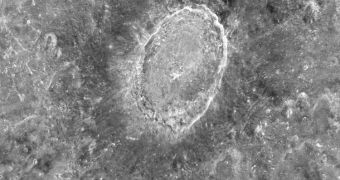Between June 5-6, Venus will complete its last solar transit this century. Astronomers are currently getting ready to observe the event with numerous telescopes, both on the ground and in orbit, and the Hubble has recently undergone a series of calibrations to enable it to zoom in so close to home.
In the image to the left, the massive Tycho impact crater on the surface of the Moon is pictured in great detail. Researchers trained the famous NASA telescope on this landscape feature in order to analyze sunlight reflected back from the object's surface.
When Venus passes in front of the Sun, a small portion of sunlight will arrive on Earth carrying data regarding the chemical composition of our neighboring world's atmosphere. Scientists are extremely interested in acquiring such information.
Pressure is also on to observe this event before it's too late. The last Venusian transit occurred on June 8, 2004, and the last one before that on December 6, 1882. The next two transits will take place on December 10-11, 2117 and December 8, 2125, so no astronomers alive today will be there to see them.
The upcoming event will be visible from North America when it begins, and from Europe when it ends. People living in the Pacific area, eastern Asia, Australia, Alaska and Hawaii will get front row seats.
Since Hubble cannot be trained on the Sun directly, astronomers plan to point it at Earth's Moon, and analyze the sunlight bouncing off of it, after passing through the Venusian atmosphere. In effect, our planet's natural satellite will be used as a mirror.
The NASA telescope will not be employed for conducting studies of the planet's atmosphere proper. Rather, it will test to see whether this study technique can be applied when analyzing the atmospheres surrounding Earth-like planets outside our solar system.
Since they already know the chemical makeup of Venus' atmosphere, they will cross-reference this dataset with Hubble readings, and determine the accuracy of data collected by analyzing light bouncing off the lunar surface.
All of Hubble's most important instruments, the Advanced Camera for Surveys (ACS), Wide Field Camera 3 (WFC-3), and Space Telescope Imaging Spectrograph (STIS) will be used for this study.
“During the transit, Hubble will snap images and perform spectroscopy, dividing the sunlight into its constituent colors, which could yield information about the makeup of Venus's atmosphere,” NASA experts say in a statement.
“Hubble will observe the Moon for seven hours, before, during, and after the transit so the astronomers can compare the data. Astronomers need the long observation because they are looking for extremely faint spectral signatures. Only 1/100,000th of the sunlight will filter through Venus's atmosphere and be reflected off the Moon,” they conclude.

 14 DAY TRIAL //
14 DAY TRIAL //